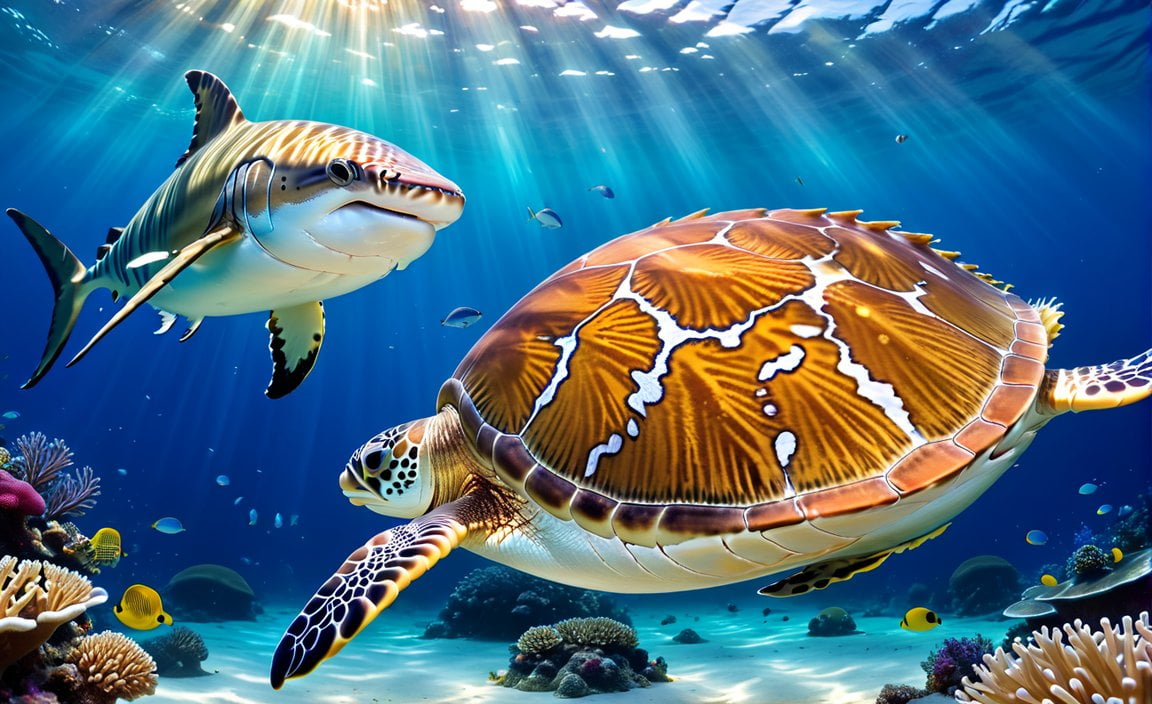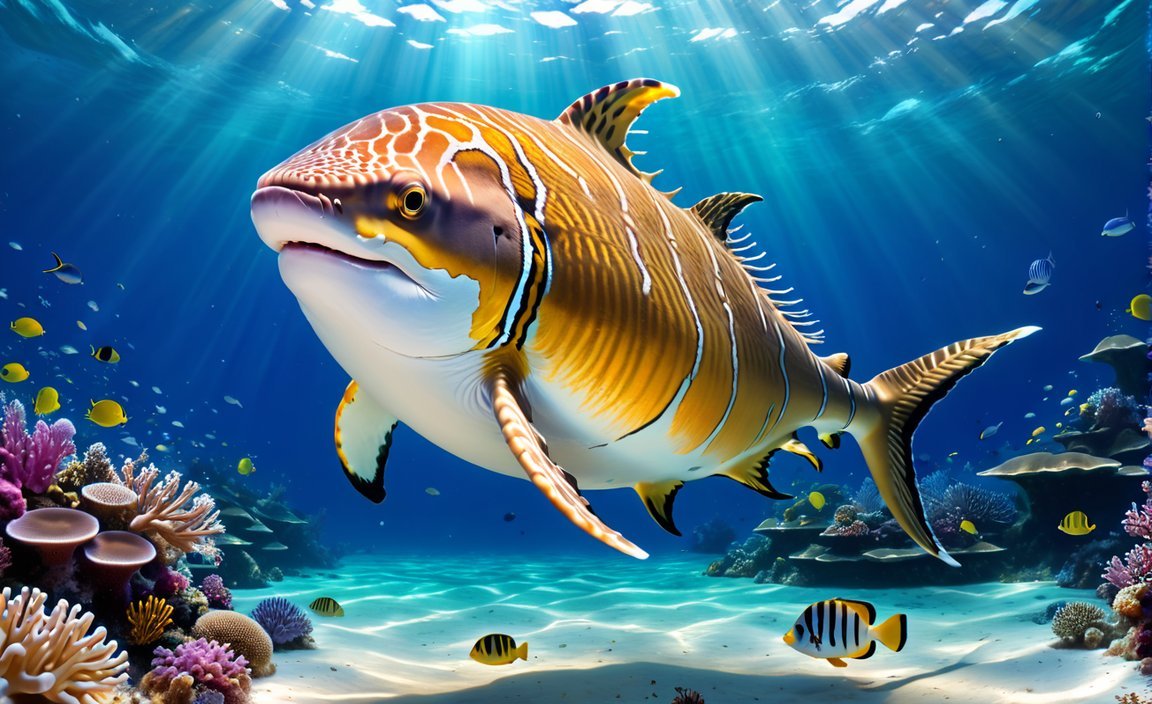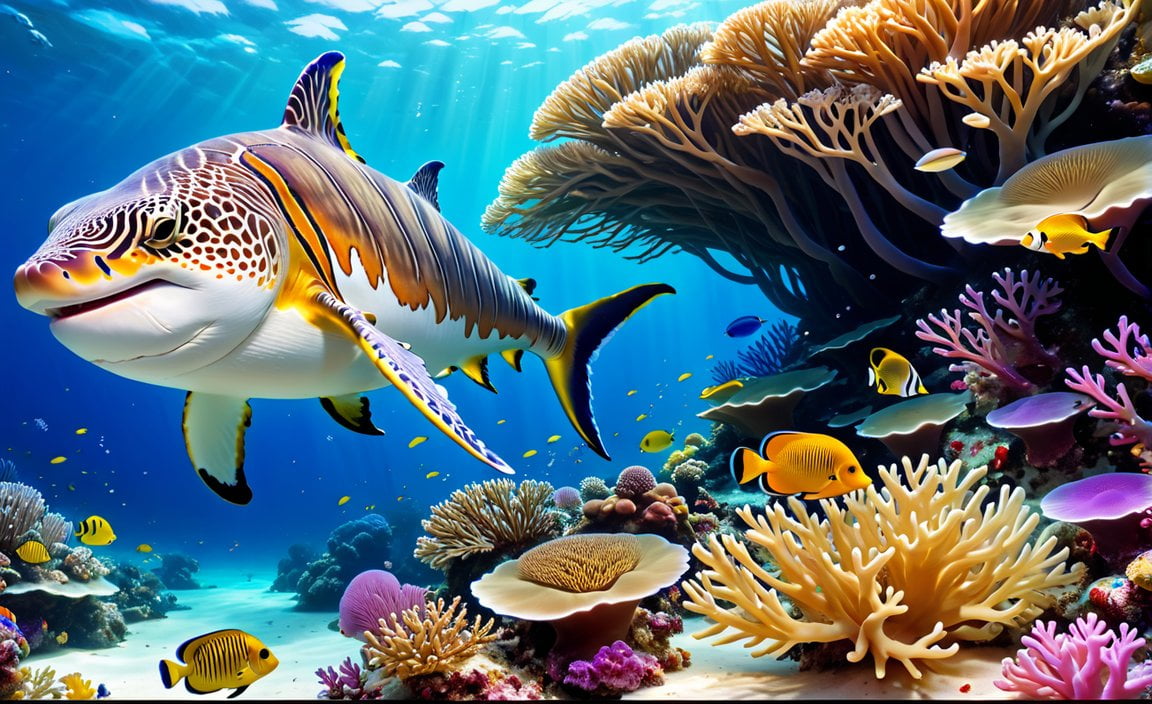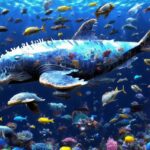Welcome to the enchanting world of oceanic marvels, where we dive deep into the realm of sea animals to unravel the astonishing wonders that await. In this article, we will embark on an extraordinary journey through the waters, uncovering ten amazing facts that showcase the remarkable capabilities and unique attributes of our marine friends. From the mysterious depths of the ocean to the vibrant shallows, prepare to be captivated by the awe-inspiring world of sea animals as we delve into their fascinating lives and unveil the secrets of the deep. Discover 10 Amazing Facts about Sea Animals: Unraveling the Wonders of the Ocean.
Key Takeaways:
- Seahorses are unique among animals as the male gives birth and cares for their young.
- Shrimps have their hearts in their heads.
- Sea sponges are alive despite lacking many organs, including a head, mouth, and eyes.
- Turtles can be found on every continent except Antarctica.
- The blue whale is both the largest sea mammal and the largest known animal in the world.
- Sea turtles have existed since the time of dinosaurs.
- Some sharks, like the great white shark, are warm-blooded.
- Sea lions, seals, and walruses are called pinnipeds due to their winged feet.
- Dolphins have excellent hearing and vision.
- Whales communicate through singing.
- Sharks have an incredible ability to detect one part of blood in 100 million parts of water.
- The giant crab of Japan can grow up to 12 feet across.
- The world’s oceans host up to 1 million species, with two-thirds yet to be described.
10 Amazing Facts about Sea Animals

Seahorses are fascinating creatures. Did you know that they are the only animals in which the male gives birth and cares for their young? It’s a truly unique characteristic that sets them apart from other sea animals[^1^]. Another surprising fact is that a shrimp’s heart is located in their head. It’s quite unusual, but it just goes to show how diverse and incredible sea animals can be[^1^].
Sea sponges may seem simple, but they are truly remarkable. They have no head, mouth, eyes, feelers, bones, heart, lungs, or brain, yet they are alive. It’s incredible how they thrive without any of the organs or systems that most animals rely on[^1^]. On the other hand, turtles can be found living on every continent except Antarctica. They have managed to adapt to various environments and possess the ability to survive in both land and sea[^1^].
When we think of massive sea creatures, the blue whale immediately comes to mind. This magnificent creature is not only the largest sea mammal but also the largest known animal in the world[^1^]. It’s awe-inspiring to think about the sheer size of these magnificent creatures.
Sea turtles have been around for millions of years and have witnessed the rise and fall of dinosaurs. They have a rich history and have managed to survive throughout the ages[^1^].
While sharks may seem frightening, they have some fascinating traits. Some shark species, like the great white shark, are warm-blooded. This adaptation allows them to hunt in colder waters and provides them with a competitive advantage[^1^].
We often associate sea lions, seals, and walruses with their distinctive flippers. These creatures, known as pinnipeds, have winged feet that allow them to navigate the water with ease[^1^].
Dolphins are renowned for their intelligence, and they possess excellent hearing and vision. These abilities have helped them thrive in their oceanic habitats[^1^].
Whales, on the other hand, communicate through singing. Their melodic calls can carry across vast distances, allowing them to connect with others and navigate through the depths of the ocean[^1^].
The sense of smell is another incredible ability found in sea animals. Sharks, for example, can detect one part of blood in 100 million parts of water[^1^]. It’s an unparalleled skill that enables them to locate prey from miles away.
Lastly, let’s talk about the giant crab of Japan. This colossal creature can grow as large as 12 feet across, showcasing the immense diversity of sea life[^2^].
These are just ten of the countless astounding facts about sea animals. It’s a testament to the wonders of the ocean and the incredible creatures that call it home. With such diverse adaptations and extraordinary abilities, sea animals continue to intrigue and captivate us. Exploring the hidden depths of our oceans promises even more astonishing discoveries in the future[^1^].
Sources
[^1^]: Ten Amazing Facts About Ocean Animals
[^2^]: Facts & Information About Sea Animals for Children
[^3^]: 15 Interesting Facts About Sea Animals
Here are some interesting articles about aquatic animals, endangered animals in India and Pakistan, and endangered animals of Arunachal Pradesh. Each sentence contains a hyperlink that will take you to the respective article:
10 amazing facts about aquatic animals: Dive into the fascinating world of aquatic animals and discover 10 amazing facts that will leave you in awe.
10 endangered animals in India: Explore the rich biodiversity of India and learn about 10 endangered animals that need our urgent attention for conservation.
10 endangered animals in Pakistan: Pakistan is home to a diverse range of wildlife, but unfortunately, many species are endangered. Discover 10 of these precious animals and the efforts being made to protect them.
10 endangered animals of Arunachal Pradesh: Uncover the beauty of Arunachal Pradesh, a state in India, and get to know 10 of its endangered animals that are struggling to survive in their natural habitats.
Feel free to click on any of the links above to learn more about these captivating topics!
The Extraordinary Communication Methods Used Underwater

Did you know that communication is crucial not only for us humans but also for sea animals? The fascinating world of underwater creatures is filled with extraordinary communication methods that help them navigate their environment, find mates, and protect themselves. In this article, we will explore ten amazing facts about sea animals and uncover the secrets of their communication methods.
Fact 1: Ocean Animal Biodiversity
The Earth’s oceans are home to an estimated 230,000 known species. Despite this staggering number, we have only explored a mere 5% of the Earth’s oceans. Imagine the hidden treasures and undiscovered communication methods that await us in the depths of the sea!
Fact 2: The Magnificence of the Blue Whale
The oceans hold many wonders, and one of the most majestic creatures is the blue whale. As the largest animal on Earth, a blue whale can reach lengths of up to 100 feet and weigh up to 200 tons. This gentle giant communicates through mesmerizing underwater songs, allowing them to connect across vast distances.
Fact 3: Secrets of the Greenland Shark
While the blue whale reigns as the largest animal, the world’s oldest animal resides in the depths of the ocean. The Greenland shark can live for over 400 years, making it the longest-living vertebrate known to science. Imagine the wealth of knowledge and intricate communication methods this ancient creature possesses!
Fact 4: Adaptable Sea Stars
Some ocean animals exhibit remarkable adaptability, such as the ability of certain fish to change gender. Take, for example, the clownfish. In response to changes in their social structure, clownfish have the incredible ability to change sex, ensuring the survival of their species. This adaptability extends beyond communication, highlighting the interconnectedness of underwater life.
Fact 5: Bioluminescence: Nature’s Light Show
The ocean is filled with bioluminescent creatures that produce their own light. This light serves various purposes, such as communication, mating, or defense. Picture a world where sparkling lights dance in the darkness, guiding these remarkable creatures through their underwater realm.
Fact 6: The Mysteries of the Deep Sea
The deep sea presents one of the most extreme environments on Earth, challenging marine life with high pressure, freezing temperatures, and perpetual darkness. However, sea animals have evolved unique communication methods and adaptations to survive in this harsh environment. For instance, the anglerfish uses a bioluminescent lure to attract prey, highlighting the ingenuity and resourcefulness of underwater communication.
Fact 7: Coral Reefs: Vibrant Ecosystems of Communication
Coral reefs, often referred to as the “rainforests of the sea,” are incredibly diverse ecosystems that support a wide range of animal species. Within these vibrant habitats, sea animals engage in intricate communication methods, ensuring the survival and success of their communities.
Fact 8: The Cry of the Whales
Whales, majestic creatures of the deep, captivate us with their melodic songs. These songs serve as a form of communication, allowing whales to communicate across vast distances. Their haunting melodies carry messages, creating a symphony that reverberates through the ocean depths.
Fact 9: Unique Communication Methods of Cetaceans
Cetaceans, including whales and dolphins, possess elaborate and extreme adaptations for acoustic communication underwater. Their complex vocalizations, known as songs, play a vital role in reproductive advertisement and maintaining social bonds. The underwater world resonates with their harmonies, a testament to the extraordinary communication methods of these intelligent beings.
Fact 10: Secrets of Caecilians
Recent discoveries have shed light on the incredible diversity of communication methods in the animal kingdom. Even limbless underwater amphibians called caecilians have been found to possess the ability to communicate through a unique form of “talking.” Unlocking these hidden communication methods brings us one step closer to unraveling the mysteries of the deep sea.
Key Takeaways:
- The oceans harbor a vast array of marine life, with an estimated 230,000 known species.
- The blue whale, the largest animal on Earth, communicates through captivating songs.
- The Greenland shark holds the title of the world’s oldest known animal, capable of living for over 400 years.
- Some ocean animals, like clownfish, possess the ability to change gender, showcasing their adaptability and survival strategies.
- The ocean is filled with bioluminescent creatures that utilize their own light for communication, mating, and defense.
- The deep sea presents extreme conditions, but sea animals have developed unique communication methods and adaptations to thrive.
- Coral reefs support a diverse range of animal species and serve as vibrant ecosystems of communication.
- Whales communicate across vast distances through melodic songs.
- Cetaceans, like whales and dolphins, exhibit elaborate and extreme specializations for acoustic communication underwater.
- Caecilians, limbless underwater amphibians, have recently revealed their own fascinating communication abilities.
Sources:
– All That’s Interesting – “Ocean Animals Facts: 10 Amazing Things About Marine Life”
– BBC – “Secret communication of sea animals discovered”
The Mesmerizing Adaptations That Allow Sea Animals to Survive in Extreme Conditions
Structural Adaptations: Blending In and Surviving the Deep
- Camouflage: Deep-sea animals have evolved specialized coloration and patterns to blend with their surroundings, keeping them hidden from predators and prey.
- Bioluminescence: Many marine organisms can produce light, allowing them to communicate, attract mates, or distract predators in the darkness of the deep sea.
- Pressure-resistant bodies: Deep-sea animals have developed reinforced skeletal systems and flexible tissues to withstand the extreme pressures of the deep ocean.
Physiological Adaptations: Dealing with Extreme Environments
- Temperature tolerance: Polar marine animals have antifreeze proteins that prevent ice crystal formation in their tissues, enabling them to survive freezing waters.
- Osmoregulation: Marine animals in highly saline environments, like hydrothermal vents, have specialized mechanisms to regulate their internal salt levels and osmotic balance.
- Chemoautotrophy: Animals in hydrothermal vent environments rely on chemoautotrophic bacteria for energy, utilizing unique biochemical pathways to process the sulfur compounds produced by these bacteria.
Behavioral Adaptations: Strategies for Survival
- Feeding strategies: Deep-sea animals employ various feeding strategies to overcome scarce food resources, including filter feeding, scavenging, and forming symbiotic relationships with bacteria.
- Reproduction: Marine animals in extreme environments adapt their reproductive strategies to ensure the survival of their offspring, such as mass spawning events or specialized brooding behaviors.
- Sensory adaptations: Many marine animals have enhanced senses, such as heightened perception of vibrations or electrical impulses, to navigate and locate prey in their lightless environments.
Relevant Sources:
- McMullin, E. R., Bergquist, D. C., & Fisher, C. R. (2000). Metazoans in extreme environments: adaptations of hydrothermal vent organisms to their hostile surroundings. PubMed.
- Metazoans in extreme environments: adaptations of hydrothermal vent organisms to their hostile surroundings. eLife.
Key Takeaways:
- Structural adaptations in sea animals allow them to blend in with their surroundings, produce light, and withstand extreme pressure.
- Physiological adaptations enable sea animals to tolerate freezing temperatures, regulate salt levels, and derive energy from unique sources.
- Behavioral adaptations include various feeding strategies, specialized reproductive behaviors, and enhanced sensory abilities.
- Understanding these mesmerizing adaptations provides insights into the diversity and resilience of marine life.
- Sources: PubMed, eLife.
The Astonishing Abilities of Sea Animals to Navigate Over Long Distances
Sea animals possess incredible abilities to navigate over long distances, utilizing various mechanisms to find their way in vast and ever-changing oceans. In this article, we will explore the astonishing abilities of sea animals to navigate over long distances and unravel the secrets behind their remarkable journeys.
Magnetoreception: The Navigation Sensation
One key mechanism employed by sea animals to navigate over long distances is magnetoreception. Research has shown that many migratory animals, including sea turtles and birds, possess the ability to sense Earth’s magnetic field and use it as a compass. This innate sense allows them to maintain a consistent heading and navigate their way through the oceanic environment (source: Nature, 2018).
Comparative Navigation: Exploring Similarities and Differences
To achieve a comprehensive understanding of animal navigation, it is essential to study all phases of their journeys. Scientists take a comparative approach, comparing different species, groups, or classes of animals to determine whether they use similar or different solutions for navigation. This approach helps uncover the intricate and diverse methods employed by sea animals to navigate over long distances (source: Nature, 2018).
Migratory Targets: A Specific Purpose
Marine animals, including sea lions, embark on migratory journeys with specific targets in mind. They navigate the oceanic environment, often to reach oceanic islands or offshore productive areas. These animals exhibit remarkable navigational skills, allowing them to find their way across vast distances to reach their desired destinations (source: Hindawi, 2013).
Spatial Information and Homing: A Learning Process
Migratory animals have been found to learn spatial information on a larger scale but lower acuity compared to non-migratory navigators. During their outward journey, they collect various environmental factors that help them navigate during the homing phase of their long-distance movement. This ability to navigate using learned information is vital for their successful migration (source: Frontiers, 2021).
Environmental Factors: A Treasure Trove of Navigation Tools
Animals rely on various environmental factors to aid in their navigation. From celestial cues, such as the position of the sun and stars, to ocean currents and temperature gradients, these factors provide valuable information that sea animals utilize to stay on track during their long-distance journeys (source: link.springer.com).
Influential Factors: Navigational Skills of Sea Lions
Sea lions, like many migratory animals, possess remarkable navigational skills. However, their ability to navigate is influenced by several factors, including their individual experiences, the availability and accuracy of environmental cues, and their ability to learn and adapt to new situations. These factors play a crucial role in their successful navigation over long distances (source: chillingseals.com).
Key Takeaways:
- Sea animals possess the astonishing ability to navigate over long distances using mechanisms like magnetoreception.
- Comparative studies are crucial for understanding navigation methods used by different species.
- Migratory animals, including sea lions, have specific targets in mind during their journeys.
- Animals collect environmental factors to navigate during the homing phase of long-distance movement.
- Environmental cues, such as celestial cues and oceanic factors, aid animals in navigation.
- Factors like individual experiences and environmental cues influence sea lions’ navigational skills.
Sources:
– Nature, 2018 – “Long-distance navigation and magnetoreception in migratory animals”
– Hindawi, 2013 – “Long-Distance Animal Migrations in the Oceanic Environment”
FAQ
Q1: How many known species of ocean animals are there?
A1: There are an estimated 230,000 known species of ocean animals.
Q2: What is the largest animal on Earth?
A2: The blue whale is the largest animal on Earth, reaching lengths of up to 100 feet and weighing up to 200 tons.
Q3: How old can a Greenland shark live?
A3: The Greenland shark is the world’s oldest known animal and can live for over 400 years.
Q4: What are some unique adaptations of ocean animals?
A4: Some ocean animals have unique adaptations such as the ability to change gender, bioluminescence, and pressure-resistant bodies.
Q5: What are the threats to ocean animals and their habitats?
A5: Human activities such as pollution and climate change pose significant threats to ocean animals and their habitats.
- Guatemala vs. Costa Rica: Plan Your Trip Smartly - April 16, 2025
- Master Types of Pumps: Ultimate Guide to Selection - April 16, 2025
- Unlock Types of Makeup Secrets: Master Any Look Now - April 16, 2025
















